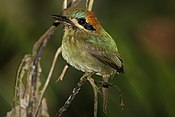Superregnum: Eukaryota
Regnum: Animalia
Subregnum: Eumetazoa
Cladus: Bilateria
Cladus: Nephrozoa
Superphylum: Deuterostomia
Phylum: Chordata
Cladus: Craniata
Subphylum: Vertebrata
Infraphylum: Gnathostomata
Superclassis: Tetrapoda
Cladus: Reptiliomorpha
Cladus: Amniota
Classis: Reptilia
Cladus: Eureptilia
Cladus: Romeriida
Subclassis: Diapsida
Cladus: Sauria
Infraclassis: Archosauromorpha
Cladus: Crurotarsi
Divisio: Archosauria
Subsectio: Ornithodira
Subtaxon: Dinosauromorpha
Cladus: Dinosauria
Ordo: Saurischia
Cladus: Theropoda
Cladus: Neotheropoda
Infraclassis: Aves
Cladus: Euavialae
Cladus: Avebrevicauda
Cladus: Pygostylia
Cladus: Ornithothoraces
Cladus: Euornithes
Cladus: Ornithuromorpha
Cladus: Ornithurae
Cladus: Carinatae
Parvclassis: Neornithes
Cohors: Neognathae
Ordo: Coraciiformes
Familia: Momotidae
Genera: Aspatha - Baryphthengus - Electron - Eumomota - Hylomanes - Momotus
Name
Momotidae G.R. Gray, 1840
References
Momotidae G.R. Gray, 1840 – Taxon details on Integrated Taxonomic Information System (ITIS).
Vernacular names
dansk: Motmoter
Deutsch: Sägeracken
English: Motmots
hrvatski: Pilari
Nederlands: Motmots
polski: Piłodzioby
português: Juruva
русский: Момотовые
Türkçe: Motmotgiller
The motmots or Momotidae are a family of birds in the near passerine order Coraciiformes, which also includes the kingfishers, bee-eaters and rollers. All extant motmots are restricted to woodland or forests in the Neotropics, and the largest are in Middle America. They have a colourful plumage and a relatively heavy bill. All except the tody motmot have relatively long tails that in some species have a distinctive racket-like tip.
Behaviour
Motmots eat small prey such as insects and lizards, and will also take fruit. In Nicaragua and Costa Rica, motmots have been observed feeding on poison dart frogs.[1]
Like most of the Coraciiformes, motmots nest in tunnels in banks, laying about four white eggs. Some species form large colonies of up to 40 paired individuals. The eggs hatch after about 20 days, and the young leave the nest after another 30 days. Both parents care for the young.[2]
Motmots often move their tails back and forth in a wag-display that commonly draws attention to an otherwise hidden bird. Research indicates that motmots perform the wag-display when they detect predators (based on studies on turquoise-browed motmot) and that the display is likely to communicate that the motmot is aware of the predator and is prepared to escape.[3] This form of interspecific pursuit-deterrent signal provides a benefit to both the motmot and the predator: the display prevents the motmot from wasting time and energy fleeing, and the predator avoids a costly pursuit that is unlikely to result in capture.
There is also evidence that the male tail, which is slightly larger than the female tail, functions as a sexual signal in the turquoise-browed motmot.
In several species of motmots, the barbs near the ends of the two longest (central) tail feathers are weak and fall off due to abrasion with substrates, or fall off during preening, leaving a length of bare shaft, thus creating the racket shape of the tail.[2] It was however wrongly believed in the past that the motmot shaped its tail by plucking part of the feather web to leave the racket. This was based on inaccurate reports made by Charles William Beebe.[4] It has since been shown that these barbs are weakly attached and fall off due to abrasion with substrates and during routine preening. There are however also several species where the tail is "normal", these being the tody motmot, blue-throated motmot, rufous-capped motmot, and the Amazonian populations of the rufous and broad-billed motmots.
Taxonomy
Family Momotidae
| Image | Genus | Living Species |
|---|---|---|
 |
Hylomanes Lichtenstein, 1839 |
|
| Aspatha Sharpe, 1892 |
|
|
 |
Momotus Brisson, 1760 |
|
 |
Baryphthengus Cabanis & Heine, 1859 |
|
 |
Electron Gistel, 1848 |
|
 |
Eumomota P.L. Sclater, 1858 |
|
A fossil genus of Oligocene coraciiform from Switzerland has been described as Protornis; it might be a primitive motmot or a more basal lineage. A partial momotid humerus found in early Hemphilian (Late Miocene, c. 8 mya) deposits in Alachua County, USA has not been named; it might belong to an extant genus.[5]
References
Master, Terry L. (1999). "Predation by Rufous Motmot on Black-and-Green Poison Dart Frog" (PDF). Wilson Bull. 111 (3): 439–440.
Forshaw, Joseph (1991). Forshaw, Joseph (ed.). Encyclopaedia of Animals: Birds. London: Merehurst Press. pp. 143–144. ISBN 978-1-85391-186-6.
Murphy, Troy G. (2006). "Predator-elicited visual signal: why the turquoise-browed motmot wag-displays its racketed tail". Behavioral Ecology. 17 (4): 547–553. doi:10.1093/beheco/arj064.
Beebe, W. (1910). "Racket formation in the tail-feathers of the motmots". Zoologica. 1 (5): 140–149.
Becker, Jonathan J. (1986). "A Fossil Motmot (Aves: Momotidae) from the Late Miocene of Florida" (PDF). Condor. 88 (4): 478–482. doi:10.2307/1368274. JSTOR 1368274.
Further reading
Murphy, Troy G. (2007). Lack of melanized keratin and barbs that fall off: how the racketed tail of the turquoise-browed motmot Eumomota superciliosa is formed. Journal of Avian Biology 38:139–143.
Murphy, Troy G. (2007). Racketed tail of the male and female turquoise-browed motmot: male but not female tail length correlates with pairing success, performance, and reproductive success. Behavioral Ecology and Sociobiology 61:911–918.
Murphy, Troy G. (2007). "Dishonest 'preemptive' pursuit-deterrent signal? Why the turquoise-browed motmot wags its tail before feeding nestlings". Animal Behaviour. 73 (6): 965–970. doi:10.1016/j.anbehav.2006.10.020.
Retrieved from "http://en.wikipedia.org/"
All text is available under the terms of the GNU Free Documentation License

